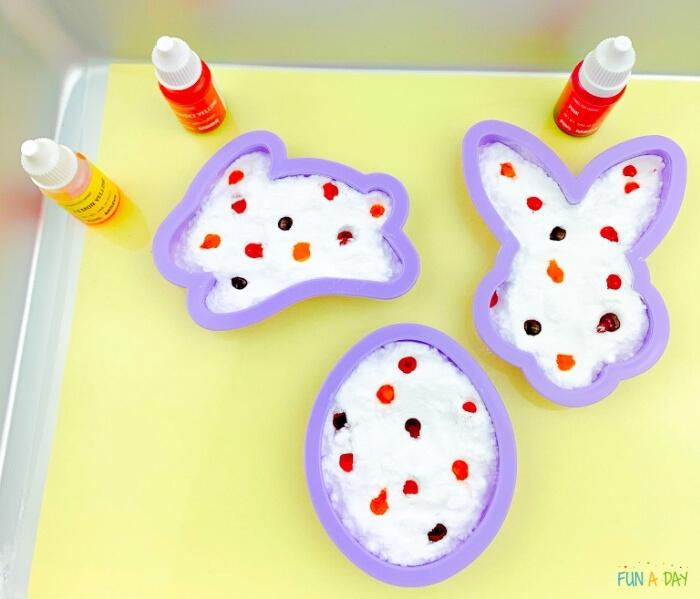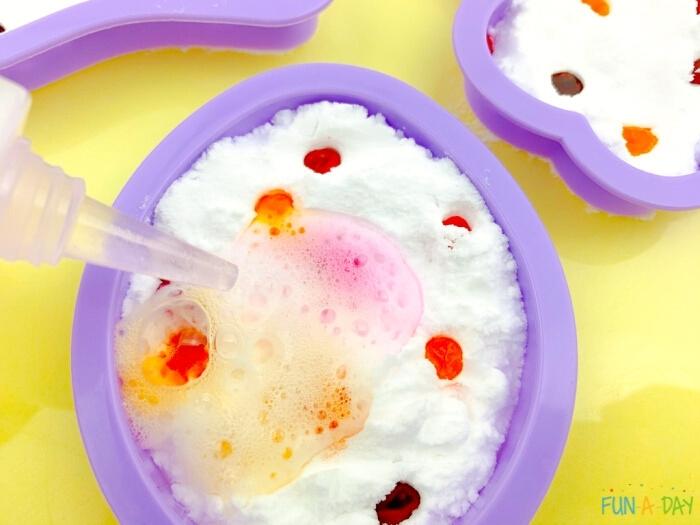Enthrall your preschoolers with this Easter baking soda and vinegar experiment! It is a must-try amid the rest of your Easter activities for toddlers and preschoolers.
What kid wouldn’t love this science activity that incorporates color, Easter bunnies, and dramatic fizzy chemical reactions?! If your students are anything like mine, they truly won’t want to stop. So be sure to stock up on vinegar and baking soda.
Plus, this is an Easter science experiment that is incredibly easy to set-up. It doesn’t require many materials, and you can make adjustments based on your own preferences. I also love how simple it is to tweak for other themes, holidays, and ideas.

Related: Easter Egg Activities
Easter Baking Soda and Vinegar Experiment
You’ve no doubt mixed baking soda and vinegar together to create a safe-yet-exciting science experiment for your preschoolers. The simplicity of this experiment makes it a no-brainer to set up. And it provides the kids with so much entertainment.
The twist with this version is that you create this chemical reaction in . . . cute little Easter cookie cutters! You can bake Easter cookies afterward, and then use the cookie cutters for this Easter art activity.
Easter Science Materials
Open up your cabinet and grab your baking soda and vinegar. And then to give it the Easter spin, you’ll really only need a few more supplies.

Here’s what we used for the Easter baking soda and vinegar experiment:
You’ll most likely want a bin or tray to catch all of the liquid, too. Depending on how many kids are participating, you could use a smaller tray or a big, shallow bin with a few sets of cookie cutters.
Even if you’re doing this outside, I suggest using a tray so you aren’t left with dried food colored baking soda everywhere!
Some substitutions: anything that will allow you to squeeze the vinegar onto the baking soda will work here, whether you want to use squeeze bottles or little droppers. Also, liquid watercolors will work just as well as food coloring.
Baking Soda Easter Experiment Directions
First, set the tray out on the table and arrange your Easter cookie cutters inside, leaving a little room around each one. Spoon baking soda inside each cookie cutter, but not quite to the top. Here’s a tip: hold the cookie cutter down as you fill it so it doesn’t move while completing this step. Try to spread the baking soda evenly inside of the cookie cutter.
Next, add some small drops of food coloring to the cookie cutters. Let the kids make a face on the bunny and designs on the eggs. Or just let them drip random drops of color throughout.

Related: Easter Sensory Activities
For simplicity’s sake, we only used a few similar colors. You can explore color mixing if you want. For example, use red and yellow dye to start with and let the kids explore what happens. Or just let the kids choose the colors. Whatever works best for you!
Now it’s time for the science fun! Let the kids squeeze some vinegar from the bottle onto their creations and watch the reaction that takes place! Continue the step above until the entire cookie cutter is colored in.

Related: Printable Bunny Shape Mats
Consider having the kids start out with smaller vinegar drops. Then they can work their way up to more to see how the reaction builds. You also can have them come up with their own techniques for squeezing, and let them experiment however they see fit. This is a great time to let them explore the creativity of science.
Like I said, they’ll probably want to repeat this science experiment, so make sure you have plenty of supplies on hand! Another fun idea would be to add glitter or sequins or a tiny hidden Easter toy to the baking soda.
Scientific Method for Kids
Baking soda vinegar science experiments are an ideal way for preschoolers to be introduced to science concepts. This magical combination of ingredients is always a show stopper, and when you have their attention you can introduce them to the scientific method.
Yes, the scientific method! It’s definitely not too difficult to discuss with young children. In fact, you might be surprised at how simple it is. When it comes down to it, the scientific method is a process to follow when investigating.
Here are the basics of the scientific method for preschoolers:
- Observe
- Ask a question
- Make a hypothesis
- Test
- Make notes and analyze what happened
- Discuss
While that sounds like a lot of steps, many of them come along quite naturally during preschool science experiments.

Before the reaction, ask the kids what they think will happen when the vinegar is dripped onto the baking soda. Then ask them if they think water would do the same thing. Ask them to tell you what they see happening. Encourage the children to think about what they can smell, hear, and feel, too.
Now is the perfect time to explain the chemical reaction that happens when some substances are mixed together. A super-simple explanation is that when baking soda and vinegar mix, they create water and carbon dioxide. The carbon dioxide creates the bubbles in the reaction. (Like soda bubbles!)
Besides exploring science, the kids will get a taste of sensory input, color mixing, working together, and learning a few new concepts. This is a pretty packed Easter science activity!

Easter Books
Why not read your kids a book or two while they’re being Easter scientists? These Easter books will entertain them as they experiment, making this Easter science experiment even MORE fun!
Done-for-you Preschool Resources
Spend more of your time with your preschoolers and a lot less time planning! Preschool Teacher 101 can help with our fully-developed resources..
Click on each image below to explore what is included in each.

The post Colorful Easter Baking Soda and Vinegar Experiment appeared first on Fun-A-Day!.




